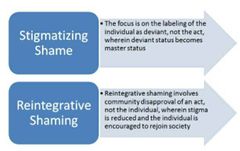![]()
![]()
![]()
Use LEFT and RIGHT arrow keys to navigate between flashcards;
Use UP and DOWN arrow keys to flip the card;
H to show hint;
A reads text to speech;
20 Cards in this Set
- Front
- Back
|
Diversion |
in the criminal justice system refers to any program, procedure, or practice that partly or entirely deals with criminal activity outside of the formal criminal justice system (Griffiths, 2015). |
|
|
Labelling Theory |
focuses on the impact of labels (e.g., criminal, ex-convict, inmate) on individuals and how the stigma that results from some labels can limit prosocial integration and opportunities. |
|
|
stigmatizing shame and reintegrative shame |

. Both forms of societal reaction are described below: |
|
|
Conditional Discharge |
EG: Todd is given a conditional discharge by his sentencing judge and receives a mandatory period of probation. |
|
|
Suspended Sentence |
EG: Sir Alfred receives a suspended sentence with a mandatory period of incarceration from the sentencing judge. |
|
|
Intermittent Sentence |
EG: Brenda is given an intermittent sentence of 60 days – she will serve her jail time on weekends and when she is in the community during the week she will follow the conditions of a probation order. |
|
|
pre-employment training model |
. That is, if you are interested in becoming a probation officer, you would complete your own academic training (i.e., College Diploma, Bachelor of Arts degree), apply for a position in your respective province and, if hired, you would then complete a training program administered by the provincial correctional services |
|
|
presentence report (PSR) |
refers to a report that is intended to outline the background of the offender as well their level of risk and specific treatment need to assist a judge in determining the most appropriate sentence. |
|
|
Risk assessment |
refers to an evaluation or investigation process designed to accomplish two things: (1) characterize the risk that an individual will commit a crime or violent act in the future; and (2) develop strategies to manage or reduce that risk (Hart, 1998) |
|
|
Static risk factors |
refer to historical characteristics of the offender, such as a prior criminal record or the age at which an offender committed their first violent offence, that predict future re-offending. |
|
|
Dynamic risk factors |
refer to characteristics of an offender that contribute to their risk but are changeable. For example, criminal attitudes predict future re-offending but rehabilitative programming can change an offender’s attitudes. |
|
|
actuarial risk assessment measure |
is a decision-making survey that follows fixed or explicit rules for identifying the presence of risk factors and assigning an overall level of risk. |
|
|
intermediate sanction |
is a term used to describe a wide range of correctional programs that generally fall between probation and incarceration. These are sanctions that have been developed in response to criticisms that the justice system is either too lenient or too harsh on offenders (Morris & Tonry, 1991). Simply put, the purpose of an intermediate sanction is to provide an alternative to incarceration that still allow for increased control and supervision in the community. |
|
|
In a theoretical continuum |
of sanctions, as shown below in Figure 9.1, an intermediate sanction is intended to fit in between the use of probation and incarceration. |
|
|
shock’ deterrence |
refers to programs that are typically used with young offenders and aimed at providing a brief but intense glimpse into the criminal justice experience |
|
|
Rational Choice Theory, |
offenders are rational decision-makers with free will. Crime is the result of a decision-making process wherein offenders weigh the potential rewards and costs associated with any activity. As such, deterrence strategies should focus on increasing potential costs associated with criminal activity. |
|
|
Boot Camp |
programs are shock deterrence programs based on a militaristic model wherein the program participants earn privileges and responsibility are subject to drills and strict discipline. |
|
|
Scared Straight |
program refers to a deterrent or juvenile awareness program in which at-risk youth visit a correctional facility where they are then confronted by inmate volunteers with stories about the realities of prison. |
|
|
Intensive Supervision Probation |
(ISP) is another intermediate sanction that situates itself between traditional probation and incarceration by increasing the conditions and supervision experienced by offenders on probation. |
|
|
Electronic Monitoring (EM) |
refers to a correctional strategy that involves placing an offender under community supervision and then using electronic equipment to ensure that the conditions of supervision are fulfilled |

